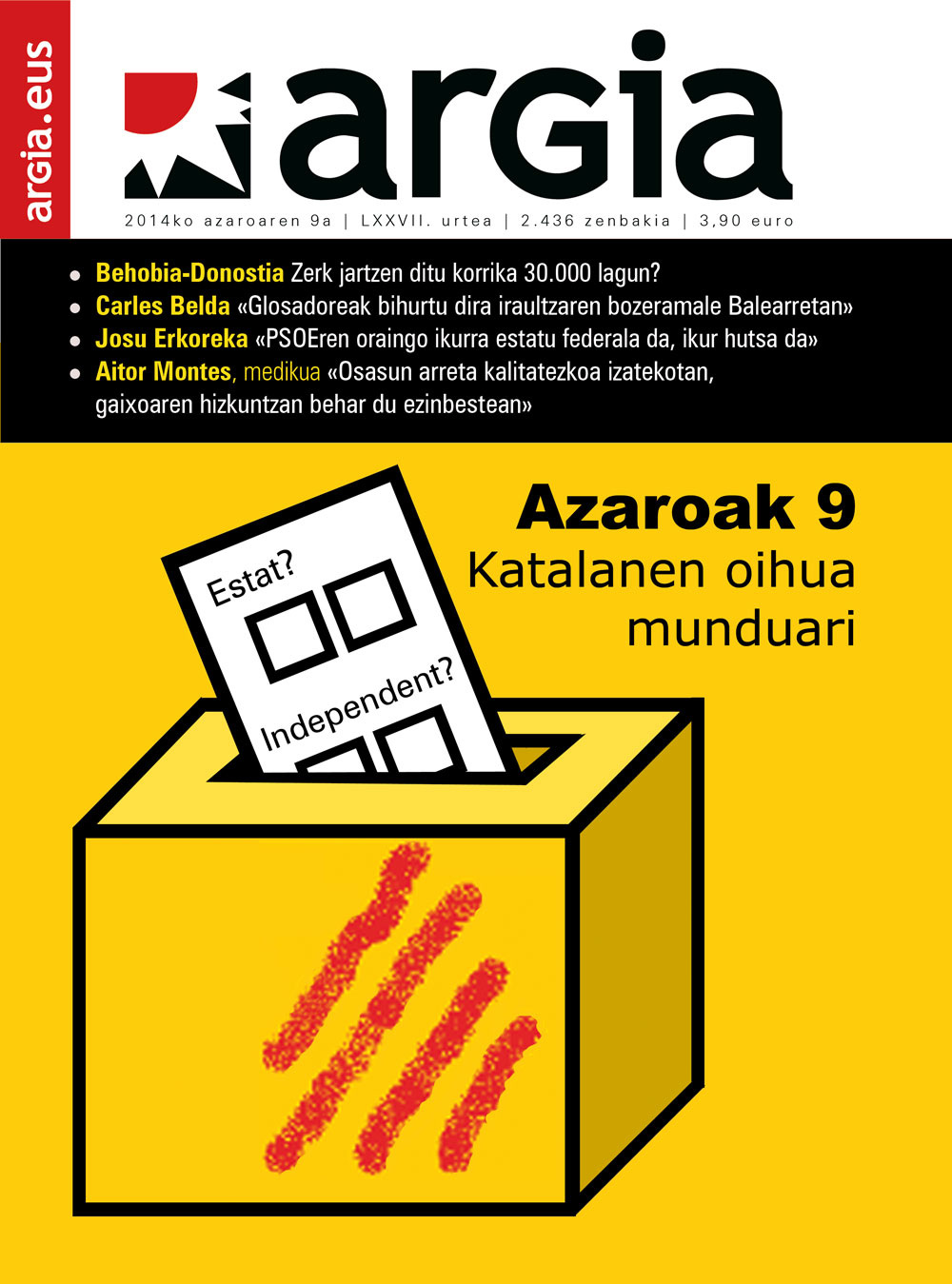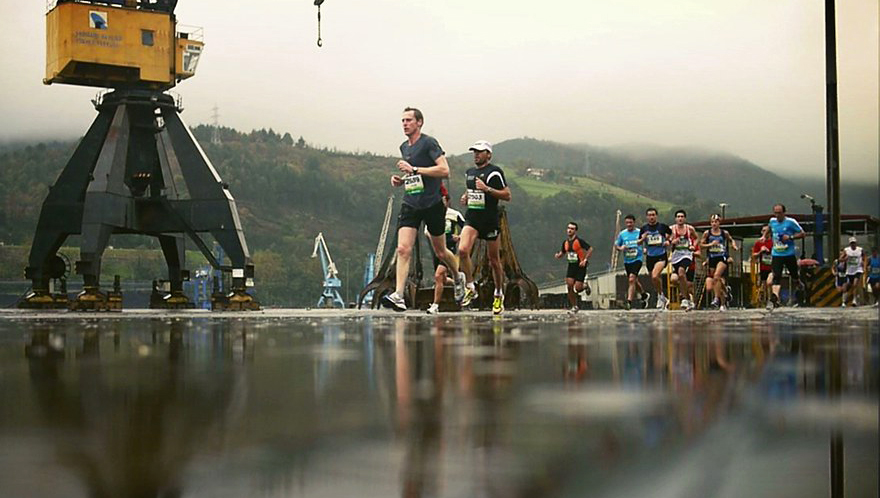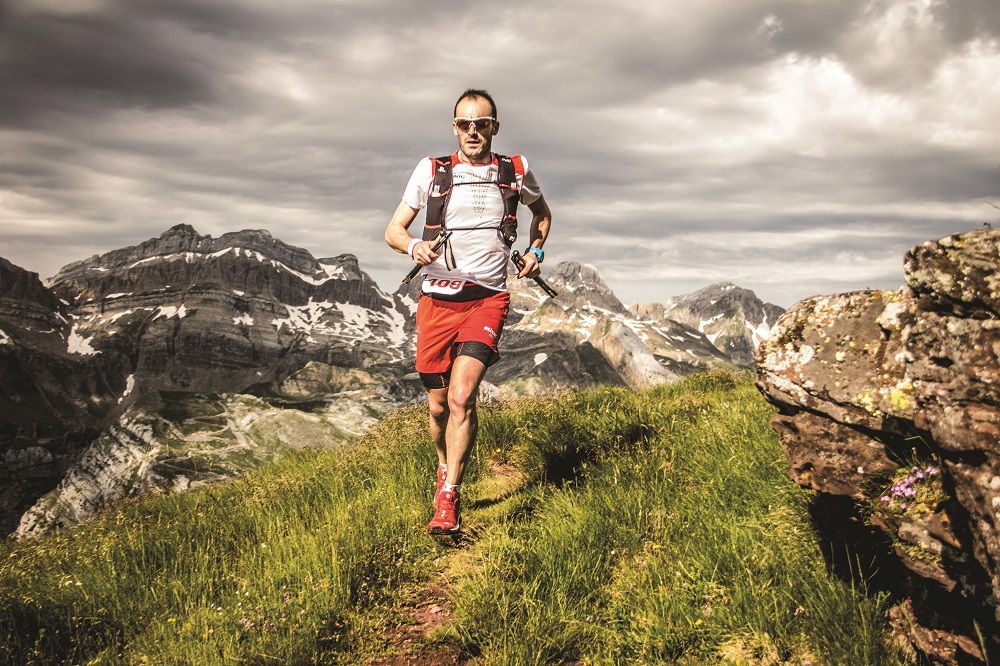Passion for running
- The streets have been filled with corridors and that is a good sign: there is the Behobia-San Sebastián. The successful career has its advantages and disadvantages, but in these times when data tells us that we are an increasingly sedentary society, we cannot deny that it is an exceptional stimulus to approach sport and encourage running.
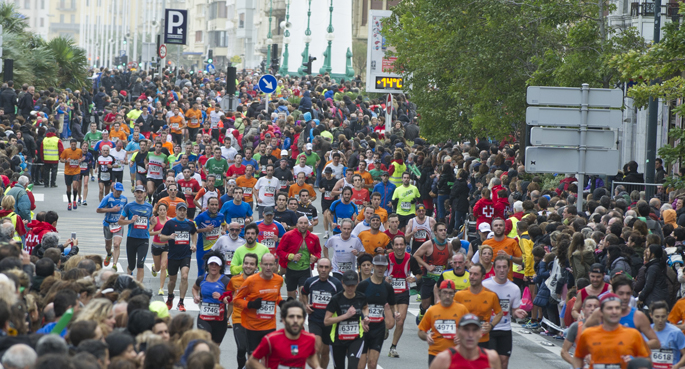
“Why do I run? Why does competition dominate me? I don't know, I think there's no reason. As an excuse, I want to feel endorphins when I get tired, have the need to feel the emotion that makes me win a career or see beautiful landscapes. I can say that I run for the well-being that produces me, so that I can disconnect from health or problems. No, I think I only run because I like it, I enjoy every moment and I don’t need to think about why.” They are words of Kilian Jornet, a Catalan corridor of the tip, extracted from the book Correr or die. In search of these sensations, there are many people who wear sneakers and run to the asphalt or to the mountain.
However, data show that more than half of the Basque population is sedentary. For example, the World Health Organization's minimum physical activity does not reach 31% of the CAPV population: The WHO recommends performing mild physical activity of 150 minutes a week, and in many countries it has reduced the demand to 75 minutes (i.e., one hour and a quarter a week), due to the high health of people. Obesity has increased among children, and along with an unbalanced diet, the inactive lifestyle has a lot to do with it. “Passive leisure is increasing and more and more available, we have it very integrated in our lifestyle,” said sports doctor José Manuel González Aramendi. Experts are concerned that the widespread passive lifestyle can be a dangerous trend.
In view of this, running has become a good solution for many. It is a cheap sport, which hardly requires resources, which can be done alone or in company, anywhere and at any time. After all, doctors recommend making a plan that keeps us active to be healthy, whether running or running any other physical activity or exercise, setting realistic, step-by-step goals. According to Dr. Gontzal Grandes, the main diseases that deteriorate or kill us quality of life are to a large extent the cause of life habits: “Inadequate food, physical inactivity, and tobacco and alcohol use are the causes of nearly 20,000 deaths annually in CAV, some 10,000 of them. By performing half an hour of daily physical activity, eating in a balanced way, not smoking and drinking to measure, we would avoid 50% of the deaths and 80% of the most common chronic diseases (heart attacks, cardiovascular system, diabetes, cancer…). These are tremendous numbers, there is nothing that has a potential impact of such magnitude.”
Elitist vs. popular races
For health, or to get away from everyday concerns, or to lose weight, with the intention of taking strength, breaking the couch... people start running, and often the hobby arises. However, sometimes it becomes an obsession and some go out to give it all in racing, mountain marches or triathlon tests. With the idea of beating brands, suspicious energy substances are distributed in specific environments, although at an amateur level. As usual, the key is in moderation, without resorting to extremes, as healthy competition can motivate you to continue doing physical exercise.
In that sense, there are careers and careers. To introduce you to some it seems you have to be almost professional, because the level of the participants is high and you can feel offside. But if it's not every weekend in this country where every month we have a career -- some criticize that they've become business -- we also have other models. The librass, for example, continues to serve to bring many women closer for the first time to the world of racing and even to start running. Family triathlons, Txakurkrosak, and, of course, the well-known San Silvestre at the end of the year are also held. Despite the more elitist character of the San Sylvestres of some peoples, the Old Year is in many places a festive race (and often disguised) to say goodbye.
What makes a career popular? Well, taking care of the details so everyone who wants to participate feels comfortable. Distance is fundamental, for example, and that is why more and more organizers offer the possibility of making different distances in the same test, so that each one chooses the alternative that suits them the most. Of course, the degree of hardness and flexibility of the journey, and the award criteria at the end (depending on the time spent or by drawing, for example) also influence. Without a chip (i.e., without a time mark) there are also races that allow you to start and finish at any time of the day, so that everyone can play at their pace and with their goals.
In Euskal Herria, if there is a popular career, it is the Behobia-San Sebastián, at least in terms of participation. Some runners complain that it's too massive, but that also allows people to gather from all the philosophies and levels. “People have told me, ‘In Behobia I go out very quiet being bad, so many people come out at my speed, that I am protected.’ Go to any other popular test and run the risk of going only in the middle of the race, or with the car broom behind, or they are taking off the tape as you go... But in Behobia, with so many people, you are always surrounded by runners, each has the opportunity to do his career and feel protected at all times, without drawing attention,” said sports expert Dorleta Ugalde. The races that manage to maintain the bottom platoon make it easier for anyone to participate.
Under the pretext of preparing the Behobia-San Sebastian, groups of citizens have been created that run in the evenings or on weekends, maintaining the fondness throughout the year. Behobia has also been an instrument for women to take a career. Thanks to Emakunde's help, women's groups were set up by counties to prepare for the race under the supervision of a coach. “Zarautz’s is the most successful and there were about 80-100 women, of all ages, 100 women without running ever! Today, they have women of all levels running and have far exceeded Behobia’s goal, participate in a lot of popular races,” Ugalde explained.
Both men and women, the 20-kilometer Guipuzkoan race will bring together a large number of people on its 50th anniversary: There will be 30,000 participants (40 of them disabled: blind, mentally ill, with problems of some branch of the body…), 221 skates, 18 hand-bikes and 3 wheelchairs. The Behobia Gaztea of 4,400 meters has also been prepared half an hour earlier, and the previous day will be the Behobia Txikia (2,800 people), aimed at the youngest. In fact, many of the race participants live the same life running as the Japanese writer Haruki Murakami: “This action was integrating into my lifestyle until it became one more part, like the three meals of the day, sleep, work or the needs of the home.” And as we have already released the report with Kilian Jornet's book, we end with the words of Murakami's book What I talk about when I talk about running: “The important thing is not to compete against time. Surely, from now on it makes much more sense for me to know what I will enjoy running those miles. I’ll have to start valuing and enjoying things that aren’t expressed in numbers.”
We asked four people who will run the Behobia-San Sebastián:
Rosa Luena:
"We were very few women and embarrassed. Now I don't care how I dress or run very well.

Rosa Luena started running in 1989 for quitting smoking. A 48-year-old Andoaindarra who lives in Berriozar liked it, decided to federate and since then he is at the Zumeatarra club of Andoain. “At first it was an adventure, I didn’t know myself well as an athlete, then I started making challenges available to the trainer, to take the marks, and over the years I’ve been slowing down; now I go out to look for good sensations, to enjoy. In addition, since the beginning of the year we have a daughter who has also changed things…”.
Luena gives a lot of peace of mind to run, it's a way to free up bad mood, and when she leaves, it's just a good opportunity to think. He added that he has met people and made friends thanks to running. In Berriozar, for example, a group meets twice a week to run; initially they were six people and today they are more than twenty. “And in Pamplona, in the Plaza del Castillo there are about 40 runners to train, it looks like a race!” However, remember the beginnings, in Andoain: “I would walk out of the house and out of the neighborhood, until I reached Leitzaran, I wouldn’t start running. At that time, we were very few women, and we were embarrassed. Today I don’t care what I’m wearing, whether it’s nice or not, it’s important that it’s comfortable, and I don’t care if I run well, but at first… When I did the Behobia-San Sebastian I put my shorts for the first time, in the training I went out with long pants. I believe that this is overcome, I hope, that today you see more women running, although less than men. Perhaps for the time, because we continue to assume the family’s accounts.”
He made the first Behobia with a friend, in 1989, and he had a great experience. This year’s is the 26th time he does so, still with the friends of the club Zumeatarrak. Throughout all these years, they have touched him all kinds of air and as at the point of departure they always go to the same bar of Irun, the tabernero already knows them. “Before I prepared myself and I went out to make a mark, now the idea is to do it at ease, in a festive atmosphere, even though I keep provoking myself and trying to do as best I can.” He says it's a special race, especially for the public: “Everyone goes out into the street to cheer and it’s amazing how they get involved. There are fans who also give us music at certain points of the route…”. Luena's recommendation that boys and girls internalize the culture of physical exercise from an early age: “On weekends, for example, taking children to the mountain, or walking around places instead of taking the car.”
Antxon Ubiria:
"They want a dormant society, people who don't move or create problems, lying on the couch."

Antxon Ubiria started running around 1987 with the intention of losing weight. That same year, he made the Behobia-San Sebastian with his older brother, “we were leaving about 3,000 people then.” The Irundarra is 47 years old and runs less and less, “because it costs more and more, especially I find it difficult to recover after training, the pains, the Juanetes… The years do not forgive, but the Behobia is my motivation and I run driven by that challenge. It serves me to work all year, even a little bit.” And that is that Ubiria has been challenged: Since 1992 he has made 22 consecutive Behobia, this year he will do the 23rd and “I have got in my skull make 25”. Then, the circumstances.
However, their goal is to get there well, without suffering too much and enjoying. “We are not physically old or eager to make a brand that I don’t know what. Some look at the brand and say, ‘This year I’m not going to do Behobia, because I’m not going to get down from that brand’, and I laugh inside me, because the winner is unique, what do all the others have to do, not participate? The goal is a healthy sport, without going crazy with the clock.” He believes that most of them are well prepared, but he has also remembered that on many occasions there have been unpleasant surprises, many times with challenges and wagering, to see who can come before. “Many people don’t realize that the Behobia is a tough race, the Avenida de Navarra de Irun, the Gaintxurizketa Hill, the ups and downs of Lezo, the high of Miraculous… It can’t be done by anyone.”
Data tells us about a sedentary society. Are we sedentary or have we been sedentary? So many WhatsApp and so many TVs… In the end the powerful want a dormant society, people who don’t move or create problems, who stay lying on the couch.”
At least on November 9, more than 30,000 people will not stay on the couch, and as every year, Ubiria will repeat the race that starts in his village. The Irundarra has many anecdotes. “About five years ago, at the end of the tour, I was feeling tired and I was constantly listening to ‘Aupa Antxon!’; I was surprised, but how do people know me?... As I reached the finish line, I realized that that year they began to name the runners on the back.” It is the most beautiful day of the year for Ubiria, a great party. “We end up in good condition, we shower and we gather more than twenty people to eat well. Today, I'm the only one that keeps coming out in Behobia. My nephew says that next year he will also come out and I'm sure he will do well; I've given him a single tip: don't go crazy with the clock and enjoy it, because Behobia is a big party."
Cristina Fernández:
"The race is an excuse to do something different, the motivation to keep running."
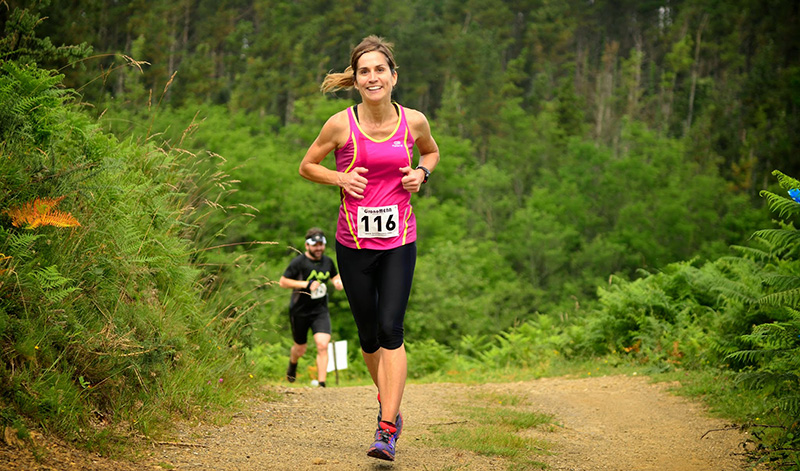
Kristina Fernandez is from Pamplona/Iruña, 38 years old and has always done sport; in his day, he was an aerobic and step monitor at the Complutense University of Pamplona. She was also going to swim, but she says that she has less and less time since she has children (the first in 2007, the third in 2013) and that it is an ideal sport from the point of view of time running, “putting down shoes and putting her on the street”, and that’s why her husband, who also runs, encouraged her. “In the end I’ve been very fond.”
Fernandez started his career last December, when he was forced to leave the career. “At first I was a little embarrassed to go out alone, I don’t know why, I never ran down the street and I felt a little ridiculous, even though I knew it’s silly, and I went with a friend. Then I have also started to leave alone, as it is difficult to coordinate schedules with my friends.” He sees more and more people running in Pamplona, “and more and more women, young and old. It’s a joy.” He also likes to run up and down mountains, “much more than asphalt. It’s harder, but much more beautiful and entertaining.” Running serves the nonsense to be better, because it makes you feel good physically and psychologically. “At times you suffer, but then you are satisfied.”
He has been running for ten months, two or three days a week, and he has already run in the middle marathon of Pamplona, in the cross of the Txantrea and in three mountain races. He has also decided to release it in Behobia, as it is a "test of the year". “The race is a motivation to train and keep running, an excuse to do something different, but I don’t look at the brand, I’m happy and I want to enjoy.”
Oihan Manzisidor:
More opportunities for sport should be offered

It is necessary to have at least 16 years to be able to participate in the Behobia-San Sebastián. Oihan Manzisidor, from Oiartzun, is 16 years old and will leave for the first time in the race. “Last year we made San Silvestre and Txingudi Korrika and this year the challenge we have put among three people is to make Behobia.” Manzisidor is going to make a mark and knows it's going to be a very special race. “I’ve seen from the outside until now, every time I’ve gone to cheer I found the number of people participating, how the audience animates, the fans there…”
He says that if he finishes to taste he will repeat next year, namely whether, because the rowing is a priority. Rowing is the real passion of the oiartzuarra. He's at the Hondarribia Rowing Club and runs on rowing training. Therefore, he considers it a complementary sport, but he does so with joy, forgetting his studies and also serves him to catch air. We asked him whether physical activity among young people should be further promoted and he told us what he lives in his environment: “At Oiartzun at least few people take sport seriously. More opportunities should be offered, although they are now working on it in the people.”
Igandean Behobia-Donostia maratoi erdia egingo dute korrika milaka herritarrek. Aro polita, dortsala soinean maratoia egin zuen lehen emakumea gogora ekartzeko. Halaxe egin du Jabier Muguruzak kantu honetan.
Korrikaren festa batzuentzat, negozio masifikatua besteentzat, aintzat hartu beharreko ekarpenak egiten ditu Behobia-Donostiak.









